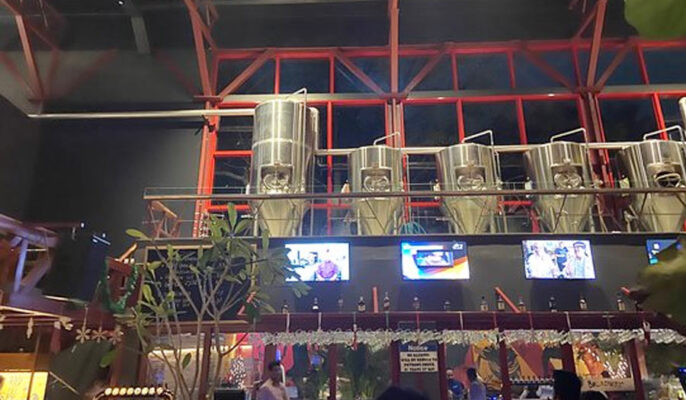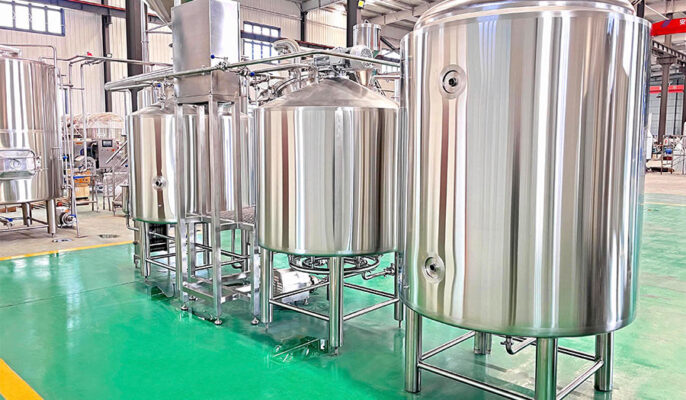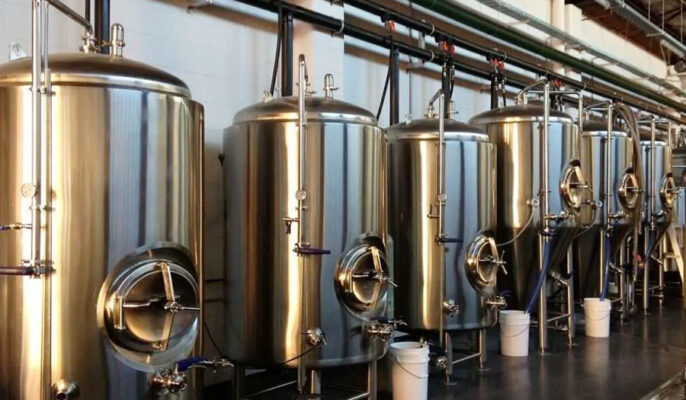マイクロブルワリー マイクロブルワリーとクラフトブルワリーには多くの共通点があるが、大きく異なる点もある。多様な選択肢に満ちた今日のビール市場において、マイクロブルワリーとクラフトブルワリーは、2つのユニークな醸造形態として、徐々に消費者の支持を獲得しつつある。両者には共通する部分も多いが、生産規模、製法特性、市場での位置づけは大きく異なる。マイクロブルワリーは、小規模で地域密着型の生産モデルと地域社会との密接な関係で知られている。一方、クラフト・ブリュワリーは、ビールの風味の革新と高品質の追求で広く注目されている。
地ビール醸造所とクラフトビール醸造所の定義と規模
地ビール醸造所とは何か?
マイクロブルワリーとは、小規模で生産量に制限のあるビール製造施設のことで、通常は年間1,500~3,000リットル程度。このような施設は、地元市場で特殊なビールを提供することに重点を置く傾向があり、製造工程における柔軟性と地域社会とのつながりを重視している。また、75%以上のビールを敷地外の場所で販売しなければならないが、訪問する消費者のために小さなテイスティング・ルームやバーを併設しているマイクロブルワリーもある。マイクロブルワリーは3つの方法のいずれかで販売を完了する:
- 三層システム:ビールメーカーは卸売業者にビールを販売し、卸売業者は小売業者にビールを販売し、小売業者は消費者にビールを販売する。
- 二層システム:ビールメーカーは卸売業者として小売業者にビールを販売し、小売業者は消費者にビールを販売する。
- 直接販売:醸造者は、テイクアウトやバーやレストランでの販売を通じて、消費者に直接販売する。

とは何か? クラフトビール醸造所?
クラフト・ブリュワリーとは、小ロット、高品質、革新性を特徴とするビール製造施設のこと。通常、伝統的な醸造方法と高品質の原料を使用し、個性的で風味豊かなビールの製造に取り組んでいる。
- プロセスの革新:クラフトビールの醸造所は、ビール独特の風味や味わいを追求するために、斬新な醸造方法や原材料の組み合わせを探求することが多い。麦芽、ホップ、酵母の種類を変えたり、果物やスパイスなど従来とは異なる原料を加えることもある。
- 少量生産:クラフトビール醸造所の規模は様々だが、通常は少量生産に重点を置いている。この製造方法により、醸造者は各バッチの品質と風味により集中することができる。
- 高品質の原料:クラフトビールメーカーは通常、高級麦芽、ホップ、酵母など、高品質の原料を選ぶ。これらの原料の選択は、ビールの風味と味に重要な影響を与える。
- 個性化と多様化:クラフトビールの醸造所は、伝統的なスタイルから革新的な実験的フレーバーまで、様々な味のビールを提供することが多い。消費者は味の好みに応じて様々なタイプのビールを選ぶことができる。
- ブランドストーリーとコミュニティとのつながりクラフトビールメーカーは通常、ブランド・ストーリーの形成と消費者との交流に重点を置いている。ブランドとの親和性やアイデンティティを高めるために、ビール祭りや試飲会などの活動を通じてコミュニティとのつながりを築くこともある。
- 市場でのポジショニング:クラフトビール醸造所は、地元市場にサービスを提供するだけでなく、国内市場や国際市場を含む流通チャネルを通じて、より広い市場に製品を宣伝することもある。

地ビールとの違い クラフトビール醸造 プロセス
マイクロブルワリーの醸造工程
- 簡素化された設備と工程:マイクロ・ブリュワリーは通常、比較的シンプルな設備と醸造工程を採用している。これらの設備は高品質のビールを製造することができるが、その技術や工程はクラフト・ブリュワリーほど複雑でも高度でもないかもしれない。
- 地域の特性:地ビールメーカーは、地元の消費者の味の好みや市場の需要に応じて、ビールのレシピを調整することが多い。このような地域密着型の製造方法は、ビールの風味の多様性につながるかもしれないが、その多様性は通常、地域の伝統や人気のある風味を中心に展開される。
- 生産の柔軟性:小規模であるため、地ビールメーカーは生産の柔軟性が高い。市場の変化や消費者からのフィードバックに応じて、生産計画やレシピを素早く調整することができる。
- 少量生産:マイクロブルワリーは通常、小ロット生産に重点を置いており、これにより醸造者は各バッチを細かく管理できるため、ビールの一貫性と鮮度を保つことができる。
クラフトビールの醸造工程
- 複雑な技術と設備:クラフトビール醸造所では通常、温度、圧力、発酵条件を精密に制御するシステムなど、より高度で複雑な設備を使用している。これらの技術は、醸造者がより繊細でユニークなビールの風味を生み出すのに役立ちます。
- 革新と実験:クラフトビールの醸造所は、製法の革新と実験を非常に重視している。新しい醸造方法、原材料の新しい組み合わせ、フルーツ、スパイス、ハチミツなどのユニークな香味添加物を試し、ユニークな個性を持つビールを造ることが多い。
- 高品質の原料:クラフトビールメーカーは通常、高品質の麦芽、ホップ、酵母を使用し、原材料の選定に非常にこだわっている。これらの高品質な原材料は、ビールの風味と味わいを高める上で重要な役割を果たしている。
- 風味と複雑さを重視クラフトビールの醸造所は、ビールの風味と味わいの複雑さに重点を置いている。醸造者は、それぞれのビールが独自の風味の特徴を発揮できるよう、各醸造工程を微調整する傾向がある。
- マーケティングとブランド構築クラフトビールメーカーは、製造工程を重視するだけでなく、ブランド・ストーリーとマーケティングも重要視している。彼らのビールには多くの場合、詳細な背景と特徴があり、それは製品の一部にもなっている。
地ビールとクラフトビールの特徴
地ビールの特徴
- 小規模生産:年間生産量は通常1,500~3,000リットル程度で、規模は小さい。
- ローカライゼーション:主に地元市場向けに、特徴的で地元風味のビールを製造している。
- 簡素化された設備:シンプルで効率的な生産設備を使用し、工程は比較的基本的である。
- 柔軟性:市場の変化や消費者の需要に対応するため、生産計画やレシピを迅速に調整する能力。
- 地域社会とのつながり:地域社会と密接につながり、試食活動や地元のお祭りを通じて交流を深めることが多い。
- パーソナライゼーション:商品の独自性とパーソナライゼーションに焦点を当て、しばしば地元の文化や伝統と組み合わせる。
クラフトビール醸造所の特徴
- 高品質の原料:高品質の麦芽、ホップ、酵母を使用し、原料の選択と加工に注意を払う。
- プロセスの革新:伝統的な醸造方法と革新的な醸造方法を用い、ユニークな風味を生み出すためにしばしば実験を行う。
- 小ロット生産:通常、生産規模は小さく、各バッチの細かい管理が可能である。
- フレーバーの多様化:複雑で重層的な味わいに焦点を当て、バラエティ豊かなビールの風味を提供する。
- ブランド・ストーリー:ブランド・ストーリーを語り、コミュニティ活動に参加することで、消費者を惹きつける。
- 市場でのポジショニング地元市場だけでなく、流通ネットワークを通じて、国内市場や国際市場を含む、より広い市場に参入することが可能である。

地ビールとクラフトビールの消費者体験は異なる
地ビールでは、消費者がその場で試飲や工場見学を楽しむ機会が多く、こうした双方向性が大きな特徴となっている。消費者と生産者が直接コミュニケーションをとることで、商品への理解と関心を高めることができる。
クラフトビール醸造所は、消費者に多様なビールの味を探求し、ブランドストーリーの共有に参加するよう促し、より豊かな試飲体験や教育的活動を提供することができる。このような体験は、現場だけでなく、オンライン活動やテイスティングセッションを通じて拡大することもできる。
よくあるご質問
地ビールとクラフトビールの主な違いは何ですか?
地ビール醸造所は規模が小さく、通常は年間生産量が1,500~3,000リットルで、主に地元市場を対象としている。クラフト・ブリュワリーは、製法の革新と高品質を重視し、規模は小規模から大規模まであるが、通常は複雑で独特な風味を重視する。
地ビールとクラフトビールの市場での位置づけの違いは?
地ビール醸造所は主に地元市場を対象としており、地域の特徴やコミュニティとのつながりを重視している。クラフト・ブリュワリーは、地元市場を対象とするだけでなく、流通ネットワークを通じて、国内市場や国際市場を含む、より広い市場にも進出している。
地ビールメーカーとクラフトビールメーカーでは、原料の選択にどのような違いがあるのでしょうか?
マイクロブルワリーは低価格の原材料を使用し、生産地の特徴を強調することがある。クラフト・ブリュワリーは通常、高品質の原材料を使用し、ビールの風味の独自性と複雑さを追求し、選択と加工によりこだわる。




